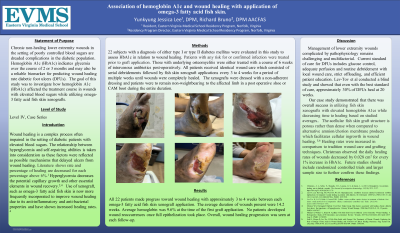Case Series/Study
(CS-033) Association of hemoglobin A1c and wound healing with application of omega-3 fatty acid fish skin.

Yunkyung Lee, DPM
Introduction: Wound healing is a complex process often impaired in the setting of diabetic patients with elevated blood sugars. Literature shows rate and percentage of healing are decreased for each percentage above 6%. The relationship between hyperglycemia and self-repairing abilities is additionally taken into consideration. The goal of this study was to investigate how hemoglobin A1c (HbA1c) affected the treatment course in wounds with while utilizing omega-3 fatty acid fish skin xenografts .
Methods: 22 subjects with a diagnosis of either type I or type II diabetes mellitus with underlying osteomyelitis were evaluated in this study to assess HbA1c in relation to wound healing. Patients had any risk for or confirmed infection treated prior to graft application. All patients received identical wound care which consisted of serial debridements followed by fish skin xenograft applications for a period of multiple weeks until wounds were completely healed.
Results: All 22 patients made progress toward wound healing with approximately 3-4 weeks between each omega-3 fatty acid fish skin xenograft application. The average duration of wounds present were 14.2 weeks. Average hemoglobin was 9.6% at the time of the first graft application. No patients developed wound reoccurrences once full epithelization took place.
Discussion: Management of lower extremity wounds complicated by pathophysiology remains challenging and multifactorial. Results demonstrate that there is overall success in utilizing fish skin xenografts with elevated hemoglobin A1cs. Healing rates are increased in comparison to tradition wound care and grafting techniques.
Trademarked Items:
References:
Methods: 22 subjects with a diagnosis of either type I or type II diabetes mellitus with underlying osteomyelitis were evaluated in this study to assess HbA1c in relation to wound healing. Patients had any risk for or confirmed infection treated prior to graft application. All patients received identical wound care which consisted of serial debridements followed by fish skin xenograft applications for a period of multiple weeks until wounds were completely healed.
Results: All 22 patients made progress toward wound healing with approximately 3-4 weeks between each omega-3 fatty acid fish skin xenograft application. The average duration of wounds present were 14.2 weeks. Average hemoglobin was 9.6% at the time of the first graft application. No patients developed wound reoccurrences once full epithelization took place.
Discussion: Management of lower extremity wounds complicated by pathophysiology remains challenging and multifactorial. Results demonstrate that there is overall success in utilizing fish skin xenografts with elevated hemoglobin A1cs. Healing rates are increased in comparison to tradition wound care and grafting techniques.
Trademarked Items:
References:

.png)